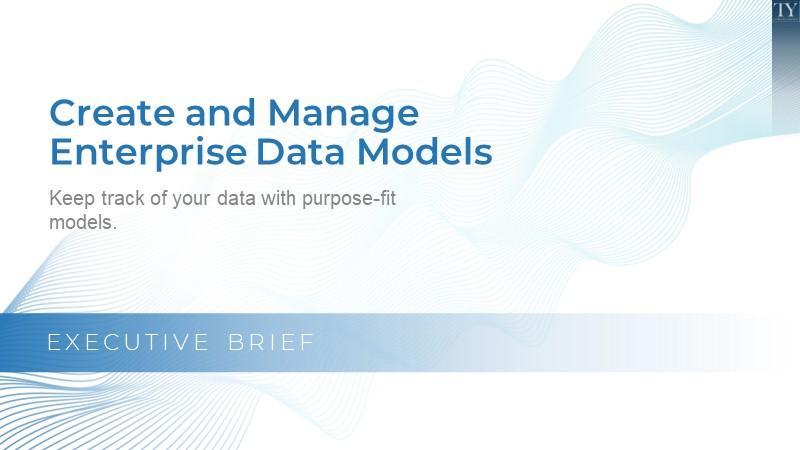
Create and Manage Enterprise Data Models
- Business executives don’t understand the value of Conceptual and Logical Data Models and how they define their data assets.
- Data, like mercury, is difficult to manage and contain.
- IT needs to justify the time and cost of developing and maintaining Data Models.
- Data as an asset is only perceived from a physical point of view, and the metadata that provides context and definition is often ignored.
Our Advice
Critical Insight
- Data Models tell the story of the organization and its data in pictures to be used by a business as a tool to evolve the business capabilities and processes.
- Data Architecture and Data Modeling have different purposes and should be represented as two distinct processes within the software development lifecycle (SDLC).
- The Conceptual Model provides a quick win for both business and IT because it can convey abstract business concepts and thereby compartmentalize the problem space.
Impact and Result
- A Conceptual Model can be used to define the semantics and relationships for your analytical layer.
- It provides a visual representation of your data in the semantics of business.
- It acts as the anchor point for all data lineages.
- It can be used by business users and IT for data warehouse and analytical planning.
- It provides the taxonomies for data access profiles.
- It acts as the basis for your Enterprise Logical and Message Models.
Create and Manage Enterprise Data Models Research & Tools
Start here – read the Executive Brief
Read our concise Executive Brief to find out why you should create enterprise data models, review Info-Tech’s methodology, and understand the four ways we can support you in completing this project.Besides the small introduction, subscribers and consulting clients within this management domain have access to:
- Create and Manage Enterprise Data Models – Phases 1-3
1. Setting the stage
Prepare your environment for data architecture.
- Enterprise Data Models
2. Revisit your SDLC
Revisit your SDLC to embed data architecture.
- Enterprise Architecture Tool Selection
3. Develop a Conceptual Model
Create and maintain your Conceptual Data Model via an iterative process.
4. Data Modeling Playbook
View the main deliverable with sample models.
- Data Modeling Playbook
Workshop: Create and Manage Enterprise Data Models
Workshops offer an easy way to accelerate your project. If you are unable to do the project yourself, and a Guided Implementation isn't enough, we offer low-cost delivery of our project workshops. We take you through every phase of your project and ensure that you have a roadmap in place to complete your project successfully.
1 Establish the Data Architecture Practice
The Purpose
Understand the context and goals of data architecture in your organization.
Key Benefits Achieved
A foundation for your data architecture practice.
Activities
1.1 Review the business context.
1.2 Obtain business commitment and expectations for data architecture.
1.3 Define data architecture as a discipline, its role, and the deliverables.
1.4 Revisit your SDLC to embed data architecture.
1.5 Modeling tool acquisition if required.
Outputs
Data Architecture vision and mission and governance.
Revised SDLC to include data architecture.
Staffing strategy.
Data Architecture engagement protocol.
Installed modeling tool.
2 Business Architecture and Domain Modeling
The Purpose
Identify the concepts and domains that will inform your data models.
Key Benefits Achieved
Defined concepts for your data models.
Activities
2.1 Revisit business architecture output.
2.2 Business domain selection.
2.3 Identify business concepts.
2.4 Organize and group of business concepts.
2.5 Build the Business Data Glossary.
Outputs
List of defined and documented entities for the selected.
Practice in the use of capability and business process models to identify key data concepts.
Practice the domain modeling process of grouping and defining your bounded contexts.
3 Harvesting Reference Models
The Purpose
Harvest reference models for your data architecture.
Key Benefits Achieved
Reference models selected.
Activities
3.1 Reference model selection.
3.2 Exploring and searching the reference model.
3.3 Harvesting strategies and maintaining linkage.
3.4 Extending the conceptual and logical models.
Outputs
Established and practiced steps to extend the conceptual or logical model from the reference model while maintaining lineage.
4 Harvesting Existing Data Artifacts
The Purpose
Gather more information to create your data models.
Key Benefits Achieved
Remaining steps and materials to build your data models.
Activities
4.1 Use your data inventory to select source models.
4.2 Match semantics.
4.3 Maintain lineage between BDG and existing sources.
4.4 Select and harvest attributes.
4.5 Define modeling standards.
Outputs
List of different methods to reverse engineer existing models.
Practiced steps to extend the logical model from existing models.
Report examples.
5 Next Steps and Wrap-Up (offsite)
The Purpose
Wrap up the workshop and set your data models up for future success.
Key Benefits Achieved
Understanding of functions and processes that will use the data models.
Activities
5.1 Institutionalize data architecture practices, standards, and procedures.
5.2 Exploit and extend the use of the Conceptual model in the organization.
Outputs
Data governance policies, standards, and procedures for data architecture.
List of business function and processes that will utilize the Conceptual model.